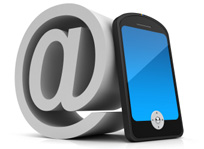The functionality of smartphones has improved exponentially in the past few years, introducing users to more sophisticated and polished interfaces and a wealth of apps alongside increasingly generous data tariffs. Consumers have embraced this technology in droves – while Gartner predicts worldwide smartphone sales to reach 468 million units by the end of this year, Ofcom research suggests that over a quarter of adults and half of teenagers in the UK already own a smartphone.
The universality of the mobile channel is challenging existing marketing approaches and preconceptions to the extent that many need a serious overhaul. And yet, while desktop computing continues to decline in popularity and Facebook continues its attack on how the world interacts, one traditional marketing channel is enjoying a renaissance in the hands of smartphone users. Email, it seems, is here to stay for now and should remain a vital tool in a marketer’s armoury.
To ensure that email marketing continues to be effective, businesses must change their approach to encompass and even favour the mobile channel. Marketers should consider the following ideas to enhance their mobile email success:
• Data: tracking the tipping point
The realisation that mobile may have already overtaken the desktop as many consumers’ primary method of engagement is dawning on many brands. The first hurdle is establishing who those consumers are. Until they click through to a web server, discovering which device a recipient uses to read your email can be tricky. Device capturing software can be used but this requires initial engagement.
Marketers already engaged in email marketing should start looking to gather this information and use it to shape their tactical and design approach. Those collecting prospect data via other means should also ensure they are collecting the right data for future mobile email strategies.
• Timing: the dead time fallacy
According to Ofcom research, the vast majority of smartphone owners in the UK (81%) never turn their device off. Though we are glued to our phones and check them almost obsessively, spare time is still a precious commodity for marketers.
The timing of emails has become more sensitive. While it was once acceptable to send a mailing late at night to appear in the recipient’s inbox first thing in the morning, this is no longer the case. Emails have changed in nature, from a letter landing softly in your inbox to be read at your leisure, to a ringing phone in the palm of your hand demanding your immediate attention.
For this reason, the time dedicated to reading individual emails has fallen significantly. Marketing emails must convey their relevancy in two seconds or less or avoid the chop. This is partly done through design and partly by ensuring the right data is available to make emails as tailored and targeted as required to achieve cut-through.
• Brevity: attention please
Though smartphone screens are getting bigger, generally space is limited. The web has already reduced readers’ attention spans and this is why online news continues to be shorter and more cursory by the day. Mobile reading is accelerating this trend – after all, no one wants to read a two-page email on their phone.
As a result, marketing emails to mobiles need to be as short and snappy as possible. Emails that are to the point and well timed are the most successful. It’s important that the value of the email is immediately obvious – so consider what recipients get in return for their time. Applying this insight will not only increase the chances of emails being read, but also mark the sender as a trusted source by email providers and avoid these automated ‘gatekeepers’ in the future.
• Design: one design to rule them all?
The temptation to send a simple text version of email campaigns for mobile users is ever present. After all, it’s an easy way of ensuring readability on mobiles. This might have cut it in the past, but the strategy is untenable today. Users increasingly expect rich content and with a two second attention window, effective design is a must. Important considerations include:
• Subject lines need to be tight and succinct. The iPhone has room for 5 or 6 short words before the ellipsis kicks in.
• The first line of text is the bait on the hook. Don’t squander it with ‘Can’t read this? Click here…’ – it’s an instant turn off. Put your mirror links at the foot.
• Use images sparingly. Remember, any images you use must be optimised to the device and getting this wrong will earn you a place in the junk folder. Plus they take a long time to download. Best to avoid them where possible.
• Experiment with background colour and font size to highlight calls to action – but keep it slick.
• Single column text is easiest to scroll through on a phone. Multiple column layouts, designed to give desktop emails a newsletter feel, are out.
• Attachments add a barrier of inconvenience to your message and increase rejection rates – use mobile optimised links instead.
• Shape your layout to match the devices and browsers your recipients are using.
• There are so many devices, browsers and email clients that the need to test is becoming increasingly important. Physically testing emails on a range of devices is a must.
Put mobile first
Design your emails for mobile first, and desktop access second.
Mobile is a sticky topic in email marketing, with good reason, but the time to tackle it is now. Marketers intending on using this channel must invest in their understanding of mobile and start experimenting to reap the benefits.






